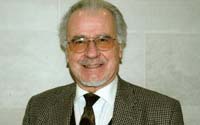TUMOURS
TUMOURS.
By DR HARALD GAIER.
Tumours, also called ‘neoplasms’ (meaning ‘new growth of tissue’), are characterised by progressive, uncontrolled proliferation of cells.
The tumour may be benign or malignant, localised or invasive. A tumour may be named for its location, for its cellular make-up, or after the person who first identified it.
Homeopathy is in the vanguard of the research in this area. Back in 1925, G B Stearns subjected a strain of fruit-flies [Drosophila malenogaster] in which approximately 50% of the males died of an inherited tumour. After administering (in homeopathic potencies) Arsenicum album, Mercurius nitrosus, and triturated (isopathic) tumour material, there was a significant reduction of the tumour-induced death rate, more or less uniformly, by an impressive factor of four.
In tests in 1980, H Choudhury transplanted the cells of a fibrosarcoma (a malignant tumour that contains fibrous connective tissue) on to mice. Twelve days later he injected one of three homeopathic substances (Kalium phosphoricum, Calcarea phosphorica, or Ferrum phosphoricum – each in a 30D potency) into their abdominal cavity. The results astounded even the investigator himself: 52% of the 77 treated mice were cured, whereas all the 77 control mice died within 10 to 15 days.
Tumours have antigenic properties. An antigen is a substance (usually a protein) that causes the formation of an antibody that reacts antigen-specifically. In other words, the antigen signals the presence of an intruder (the tumour) and stimulates protective antibody reaction.
Tumour antigens differ from normal cell antigens. For example, some tumour antigens are related to oncogenic (or ‘cancer-causing’) viruses.
In 1979 a study was published that demonstrated that the administration of an equal mixture of DNA+RNA in both the potencies 9CH and 15CH before and during the treatment of rats, exposed to the tumour-inducing carcinogen 2-Acetylaminofluorene (AAF), produced a significantly higher survival rate.
A large-scale study of 1982, involving 1002 rats, showed that the administration of Phenobarbituralum 9CH could prevent the appearance of the AAF-induced liver-cell tumours in half the animals.
Other homoeopathic substances used on a similar number of rats in this trial (AAF 9CH, RNA 9CH (without the DNA this time), and distilled water) led to no significant outcome changes.
Naturopathic and Botanical Medicine
The latter has demonstrated efficacy in both prevention and treatment of tumours. Phyto-oestrogens have shown an inverse association between these plant derivatives and prostate cancer.
The former has produced much evidence to suggest that green tea produces protective effects against cancerous tumours.
An epidemiological study covering a ginseng-growing area in South Korea assessed 4634 individuals on their ginseng intake. During the five following years they were followed up. During that period 137 cases of cancer occurred. Those who had taken fresh ginseng regularly were associated with a reduced cancer risk.
A trial of a Chinese botanical compound made from a mixture of seven herbs, known as Sho-saiko-to, involved 260 patients with hepato-cellular carcinoma and cirrhosis. They were treated with 7.5 g of the mixture daily, while the control group received Orthodox drugs only. The five-year survival rate tended to show that the life-expectancy of the herbally treated group was higher than that of the group treated with orthodox drugs.
Another published study of a different Chinese complex mixture, known as ‘destagnation’, was a randomised controlled clinical trial involving 188 patients suffering from naso-pharyngeal carcinomas. The efficacy of the traditional Chinese herbs was tested against radiation therapy. The five-year survival rate of the treated group was 53% and that of the control group was 37%. The difference is statistically significant.
Nutritional Medicine
Apart from mother’s milk and human bone marrow, the natural substances known as Alkylglycerols are most abundant in shark liver oil. In a controlled trial, in Sweden, they were shown to enhance the regression of uterine cancer when administered prior to radiation therapy. It had previously already been demonstrated that administration prior to, during and after radiation therapy for the treatment of uterine cancer, reduced radiation injuries by as much as two-thirds.
About the Author:
Dr Harald Gaier is a naturopathic physician based on Harley Street. Dr Gaier has nearly four decades of clinical experience and writes for several of today’s leading alternative medicine publications. For more information see: www.drgaier.com
For more interviews with Dr Gaier listen to PASSION for the PLANET radio or search this site for interview available on-demand.

